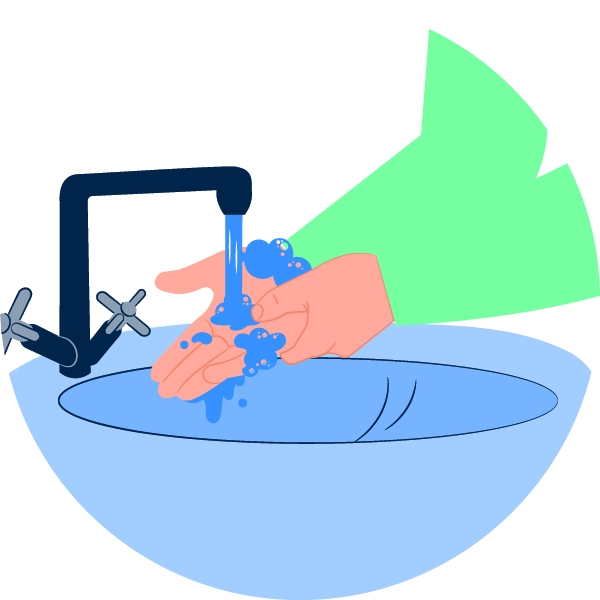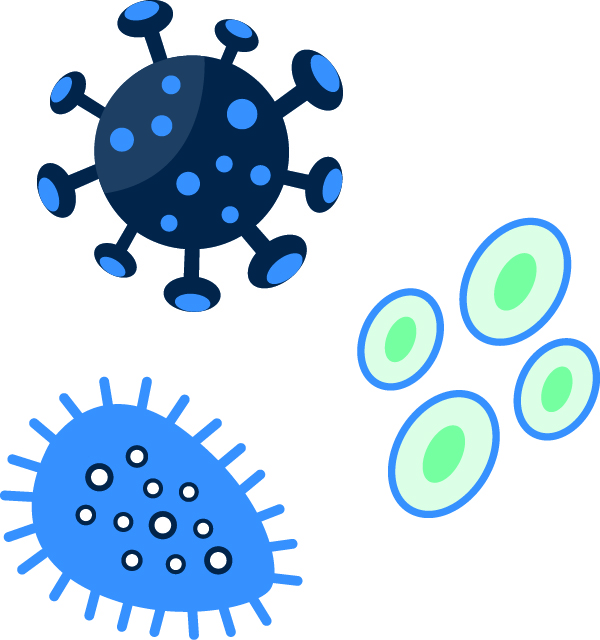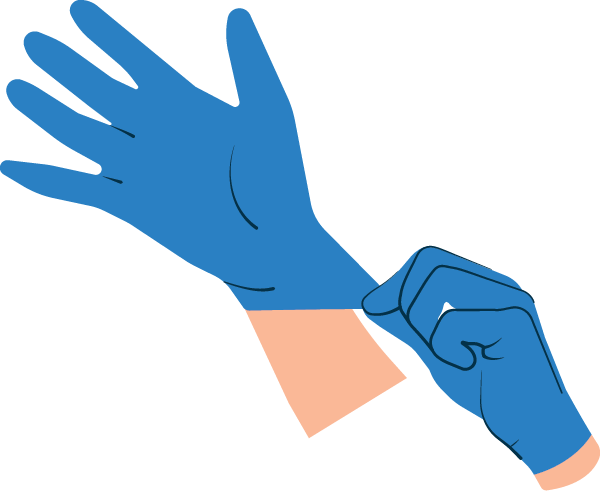- Details
That is the reason why, in line with ongoing initiatives on antibiotics, a national ‘One World, One Health’ action plan was launched to combat AMR. Indeed, an intersectoral and multidisciplinary approach remains necessary to ensure the rational use of antimicrobials. The AMR National Action Plan focuses on judiciously reducing and improving the use of antimicrobials (and antibiotics in particular), in order to prevent the development and spread of resistant microbes in humans, animals, plants and the environment. In hospitals, antimicrobial resistance is being fought by means of programmes such as Infection Prevention and Control (IPC) and Antimicrobial Stewardship (AMS), with the aim of maximising the prevention of infection transmission and supporting and encouraging the judicious use of antibiotics.
Learn more about the National Action Plan?: https://www.health.belgium.be/en/belgian-one-health-national-action-plan-fight-against-antimicrobial-resistance-2020-2024
Evolution of the consumption of antibacterial agents for systemic use expressed as the number of DDD per 1,000 bed-days
Evolution of the consumption of antibacterial agents for systemic use expressed as the number of DDD per 1,000 stays
The decreasing trend can possibly be explained by a change in the epidemiological situation in which more admissions (and therefore a larger denominator), lead to a decrease when antibiotic use is expressed as DDD per 1,000 admissions. On the other hand, a shorter length of stay (with fewer bed days and therefore a smaller denominator) may contribute towards an upward trend when antibiotic use is expressed as DDD per 1,000 bed days. Although current figures provide a good estimate of antibiotic use in Belgian hospitals, more detailed research is needed.
ESAC-Net’s online platform also allows antibiotic use to be compared with that of surrounding countries[4]. At 1.4 DDD per 1,000 inhabitants per day, (DID), Belgium scored lower than the European average of 1.5 DID and was below France at 1.7 DID in 2021. From 2012 to 2021, Belgian hospitals reduced the absolute use of antimicrobials by 17%, the largest decrease having taken place between 2019 and 2020. Despite this decrease, the prescription pattern in Belgian hospitals remains higher than in Dutch hospitals (0.7 DID in 2021).
The use of broad-spectrum antibiotics in Belgium accounted for 31% of total antibiotic use in the hospital sector in 2021. However, this percentage varies widely between different hospitals. It is important to maintain the commitment to prescribe antibiotics responsibly, based on guidelines and diagnostic results. This will ensure that broad-spectrum antibiotics are used carefully for complex cases. The role of the infectiologist is crucial in this regard.
Learn more? Read the BELMAP report! https://www.health.belgium.be/en/belmap-2022
Infection prevention
Compliance with hand hygiene by healthcare providers is considered the most important factor in preventing the transmission of healthcare-associated infections among patients. Since 2005, hand hygiene campaigns have been organised in Belgian hospitals by the FPS Public Health, in collaboration with Sciensano, to raise awareness of good practices among staff, patients and visitors and to promote hand disinfection.
In the period from 2005 up to and including 2019, we can consistently see a clear effect of the campaign to promote hand hygiene compliance. What is more, we can also observe an upward trend over time.
In 2021, the 9th campaign on hand hygiene was launched. That campaign did not involve a pre-campaign measurement. After the campaign, we can see that in 80.4% of measured situations, the rules concerning hand hygiene were followed.
Evolution in following the guidelines on hand hygiene (%)

The ninth campaign focused on improving compliance for the following indications:
- Hand hygiene in venous/arterial contact (79.3% after the campaign in 2021 vs. 80% in 2019)
- Hand hygiene for urinary tract contact (82.7% after the campaign in 2021 vs. 87.9% in 2019)
As with previous campaigns, nurses achieved the best post-campaign results (87%) compared to other healthcare providers.
Want to know more about the results?https://www.health.belgium.be/sites/default/files/sciensano_resultats_9e_campagne_nationale_hdm_2020-2021_version1.0.pdf
Would you like to know more? https://www.health.belgium.be/fr/sante/prenez-soin-de-vous/influences-de-lenvironnement/hygiene-des-mains
Would you like to know more? www.noso-info.be
Hospital Outbreak Support Teams (HOST)
The FPS Public Health, Food Chain Safety and Environment has launched Hospital Outbreak Support Teams (HOST) as pilot projects to strengthen Infection Prevention and Control (IPC) and Antimicrobial Stewardship (AMS) teams in hospitals. With these teams, the FPS also aims to increase the availability of IPC and AMS expertise for nursing homes and primary care providers.
The HOST pilot projects operate by means of two complementary axes:
- a local-regional approach focusing on resource sharing and cooperation among hospitals within a locoregional network;
- a cross-cutting approach with knowledge transfer between all partners involved.
Number of HOST projects by region
‘24 HOST pilot projects were launched in 2021 and 2022 in Belgium’
24 HOST pilot projects were launched in 2021 and 2022, of which 4 in the Brussels-Capital Region, 12 in the Flemish Region and 8 in the Walloon Region, based on a submitted and approved project proposal. Regional hospital networks designated a coordinating hospital that signed an agreement with the FPS Public Health, Food Chain Safety and Environment.
The hospital networks have established HOST teams consisting of people with expertise in infectious diseases, medical microbiology, clinical pharmacy and infection prevention and control.
The activities of 2022 and beyond will be analysed based on narrative progress reports on the following topics:
- Preparation of local IPC/AMS guidelines, tools and procedures;
- Education and training;
- Surveillance, monitoring and feedback;
- Implementing multimodal strategies to improve IPC and AMS.
Special attention was given to surveillance, with a budget of €120,000 per network allocated in 2022 to improve comprehensive epidemiological surveillance, analysis and feedback of data on antimicrobial use and healthcare-associated infections in participating hospital networks.
The integration of the HOST teams into the existing IPC and AMS structures is accompanied by challenges but is systematically improving thanks to the involvement of key actors in the hospitals, discussions in regional and national platforms and efforts to improve the interoperability of the IPC, AMS and AMR databases within the network.
A key concept of the HOST projects is the cross-fertilisation of experiences and lessons learned from the various HOST projects. In this regard, an intervision day was organised in October 2022. On the occasion of this event, several ongoing projects of the HOST teams were presented and successes, failures and lessons learned were shared among the teams. The step-by-step approach enables teams to grow and progress in the complex landscape and diverse realities of IPC and AMS in our healthcare system. Similar intervision days will also be organised in 2023 and 2024.

Learn more? https://organesdeconcertation.sante.belgique.be/fr/projet-pilote-hospital-outbreak-support-teams-host
[1] https://www.ecdc.europa.eu/en/about-us/networks/disease-networks-and-laboratory-networks/ears-net-data
[2] Bron: https://www.healthstat.be/#/main
[3] Selection of antibacterial agents for systemic use was performed on the basis of ATC code J01. Only consumption in Belgian acute hospitals excluding psychiatric services and day hospitalisations was taken into account.
[4] https://www.ecdc.europa.eu/en/antimicrobial-consumption/surveillance-and-disease-data/database
- Details
The Pay for Performance programme (P4P) was launched in 2018 for general hospitals as part of the hospital financing reform. The goal of this programme is to financially reward hospitals that achieve good results on a set of hospital-wide and pathology-related structure, process and outcome indicators. These indicators include obtaining ISQua accreditation certification and implementing a patient safety management system. It also focused on oncology indicators, such as the correct and complete transmission of data regarding the clinical and pathological stage of tumours, and mortality indicators. In recent years, there has been more of a focus on patient experiences. Hospitals receive a financial incentive based on the scores they achieve for the indicators and for the justified activity (the number of accredited beds).
The ISQua (International Society for Quality in Healthcare) accreditation quality indicator has been part of the P4P programme since its inception in 2018. To achieve ISQua accreditation, the hospital is assessed by an external, independent organisation to determine whether it is providing quality and safe care to patients. Obtaining accreditation certification requires a great deal of effort from the hospital.
Hospitals are financially rewarded in P4P, both for achieving ISQua accreditation certification and for the preparation process for hospital-wide accreditation.
Evolution percentage of hospitals by stage of accreditation
‘Increase from 17 to 39 hospitals without an ISQua accreditation in the period from 2018 to 2022.’
In the P4P programme in 2018, 46 hospitals were ISQua accredited. By 2020, there were 65. Starting in 2021, however, there was a noticeable decline. More and more (Flemish) hospitals are choosing not to reaccredit. Between 2020 and 2021, 4 Flemish hospitals decided to stop their ISQua accreditation process. Between 2021 and 2022, that number rose to 15 hospitals, almost a fourfold increase. In Brussels, between 2020 and 2021, only 1 hospital decided to no longer participate in ISQua accreditation. In Wallonia no hospital has discontinued ISQua accreditation. On the contrary, the number of Walloon hospitals with ISQua accreditation increased from 4 hospitals in 2018 to 13 hospitals in 2022.
- Details
The OECD’s Healthcare Quality and Outcomes programme (HCQO) aims to enable international comparisons of healthcare quality. Indicators are developed and reported for that purpose.
Among other things, this programme examines hospitalisations following four common chronic conditions: asthma, chronic obstructive pulmonary disease (COPD), congestive heart disease and diabetes.
For these conditions, a well-functioning primary care system can avoid costly and undesirable hospitalisations[1].
Below, we compare the number of hospitalisations for congestive heart disease and diabetes across a number of European countries[2]. The number of admissions per 100,000 of the population gives an indication of the functioning of the primary care system. For these 2 diseases, a large variation can be observed across European countries.
Number of hospital stays related to congestive heart failure per 100,000 population (2019 or latest year available)
Number of hospital stays related to diabetes per 100,000 population (2019 or latest available year)
[1]OECD (2020), Realising the Potential of Primary Health Care, OECD Health Policy Studies, OECD Publishing. Paris, https://doi. org/10.1787/a92adee4-en.
[2]Source: OECD, Health Statistics 2022
- Details
What is medical imaging?
‘Medical imaging’ is a collective term for various techniques for obtaining an image of the body. In hospitals, medical imaging is used to diagnose, detect and monitor diseases at an early stage, support medical interventions and evaluate treatments.
We can distinguish the following ‘heavy’ medical imaging devices: CT, MRI, SPECT-CT and PET. These techniques all have their strengths and weaknesses. There is therefore no generally applicable technique. What is a good imaging technique for one disorder is not always the same for another.

Number of heavy medical imaging devices in Belgium (01/01/2023)
Learn more? https://www.health.belgium.be/fr/publications-imagerie-medicale
Use of medical imaging in Belgium and Europe
Medical imaging has played a major role in the enormous progress made in modern medicine and plays an ever greater role in our healthcare. However, there is also a downside to the frequent use of techniques such as CT scans, namely the increased exposure to ionising radiation. Compared with the average number of examinations per 1,000 inhabitants in EU countries, a large number of CT examinations are performed in our country[1].
Number of examinations per 1,000 inhabitants for CT and MRI scans in the EU in 2019.
In 2019, the use of CT examinations was about 40% higher in Austria, France, Luxembourg and Belgium than the average use in EU countries. In the case of MRI, we note that the number of examinations per 1,000 inhabitants in our country (98) is noticeably lower than in France (123), Austria (148) and Germany (150).
Number of examinations per 1,000 population CT and MRI in EU in 2019
Actions for the improved use of medical imaging
To ensure that medical imaging is used more effectively, the FPS is launching several actions, both for doctors and for the general public.
For example, NIHDI, the FPS Public Health and the Belgian Medical Imaging Platform (BELMIP) are working together on the ‘Prescription Search Support for Radiology (PSSR)’ project. The goal of this project is to integrate evidence-based decision rules into physicians’ electronic prescribing environment so that they are supported in a user-friendly way when choosing whether a radiological examination is necessary and, if so, which imaging technique will best help the patient. The roll-out of this project will begin at the end of 2025.
Citizens will also be informed about situations in which a scan is often unnecessarily demanded. An example is back pain. CT scans of the lower back are still too often prescribed when it is not always indicated, which in turn contributes to the high radiation burden on the population and weighs heavily on the healthcare budget.
By means of the campaign ‘No scan without a plan’ we want to create awareness so that citizens know that in case of lower back pain, it is best not to put unnecessary pressure on their doctor to obtain a radiological examination. Indeed, many patients feel that if no examination is prescribed, their complaint cannot be investigated properly or even taken seriously and this leads to unnecessary examinations. The patient’s question stems from anxiety. It is therefore important for citizens to know that even without medical imaging, a plan of action can be created that focuses on what really helps, which is to keep moving. In exceptional cases where a radiological examination is still appropriate, the physician will always frame this examination within a larger plan of action. Hence the campaign’s slogan: ‘No scan without a plan’
Learn more? Check with your doctor or specialist or surf to: https://www.pasderayonssansreflexion.be/
[1]Source: OECD, Health Statistics 2022; Eurostat Database
- Details
An electronic health record (EHR) is a longitudinal record of a patient’s health information that is completed following contact with healthcare actors. The record ideally includes data from all clinicians involved in a patient’s care.
For many years, the Belgian government has recognised the need for the widespread deployment of EHRs so that information can be easily shared between healthcare providers and organisations. A Belgian eHealth action plan was launched several years ago. One of the action items relates to the roll-out of EHRs in hospitals.
To learn more about the eHealth Action Plan, visit: https://www.ehealth.fgov.be/fr/page/plan-d-action-esante-2022-2024
The goal is to achieve an integrated EHR in which:
- messages are exchanged between systems;
- different functions are implemented within one integrated system.
In any case, core functionalities should be integrated and data should be captured and managed according to the Original Source Principle. This means that the information is not duplicated and is retrieved from the original source.
The chart below shows an overview of the core functionalities of an electronic health record and the level of implementation by December 2022 in general hospitals.
Core functionality rollout in general hospitals (%)
A programme of financial incentives was established to promote the roll-out of EHRs. To that end, a number of Belgian Meaningful Use Criteria were defined in consultation with hospitals. In July 2022, €57 million was distributed amongst the country’s general hospitals. The budget was distributed according to the level of use of the various functionalities in the EHR.
In most areas, retrieving, aggregating and converting information into valuable insights is still a lengthy and manual process. This is due to various obstacles related to data exchange between information systems of different providers. Interoperability is important, partly because, in practice, patients often consult multiple healthcare providers during a care pathway and because information exchange between healthcare providers is crucial for optimal treatment.
The chart below shows the share of software providers for EHR as a function of the size of the hospitals[1]. Zorgi and Nexuzhealth are currently the largest providers, providing software to two-thirds of the market.
Share of software providers for EHR retrieval as a function of hospital size
[1]The size of hospitals is determined by the number of accredited beds.




